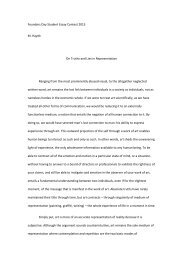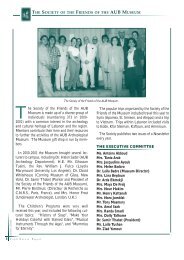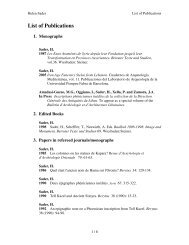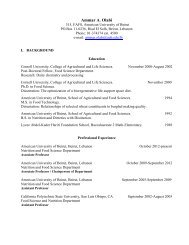The IX t h Makassed Medical Congress - American University of Beirut
The IX t h Makassed Medical Congress - American University of Beirut
The IX t h Makassed Medical Congress - American University of Beirut
You also want an ePaper? Increase the reach of your titles
YUMPU automatically turns print PDFs into web optimized ePapers that Google loves.
hemodynamic features that are considered key features in determining the appropriate<br />
management for faster recovery with the least complications and hospital stay. <strong>The</strong>se key elements<br />
can be obtained from clinical history, adequate physical examination, electrocardiogram and<br />
blood studies. In addition, with technology advancement, HF biomarkers, fluid assessment by<br />
bioimpedance and other technologies as well as bedside echocardiographic hemodynamic<br />
assessment will improve diagnostic accuracy and <strong>of</strong>fer a better optimization <strong>of</strong> individualized<br />
therapy without any invasive procedures. In this presentation clinical and hemodynamic features<br />
pertinent to HF assessment will be discussed with mentioning some <strong>of</strong> the new technologies and<br />
the future perspective in this field.<br />
ATRIAL FIBRILLATION IN HEART FAILURE<br />
Samer Nasr, MD<br />
<strong>The</strong>re is little doubt that atrial fibrillation increases mortality rates in the heart failure population.<br />
<strong>The</strong>rapy for atrial fibrillation, in the absence <strong>of</strong> heart failure, is tailored mainly for symptomatic<br />
relief and quality <strong>of</strong> life improvement.<br />
In the heart failure population, therapy should target specifically the mortality increase by:<br />
1. Either rhythm control with direct current cardioversion, amiodarone, and serious<br />
consideration for atrial fibrillation ablation<br />
2. Or aggressive rate control with a target heart rate allowing biventricular pacing above 90<br />
percent during 24 hour period.<br />
This is achieved with AV nodal ablation, if betablocker/digoxin combination is not effective.<br />
Anticoagulation is indicated in the heart failure population with atrial fibrillation in either rhythm<br />
or rate control strategies.<br />
An additional challenge we have face frequently is the programming <strong>of</strong> intracardiac defibrillators<br />
ot prevent inappropriate delivery or therapy. Multiple SVT discriminators are available with<br />
advancing technologies but tailoring <strong>of</strong> the programming to specific patient remains the<br />
cornerstone <strong>of</strong> therapy.<br />
ANEMIA AND HYPONATREMIA IN PATIENTS WITH HEART FAILURE<br />
Samer Kabbani MD , FACC, FSCAI<br />
- Understanding the pathophysiology <strong>of</strong> anemia and hyponatremia in Heart Failure.<br />
- Treatment <strong>of</strong> hyponatremia and management <strong>of</strong> anemia in Heart failure.<br />
- Outcome <strong>of</strong> patients with hyponatremia and untreated anemia in Heart failure.<br />
77
















